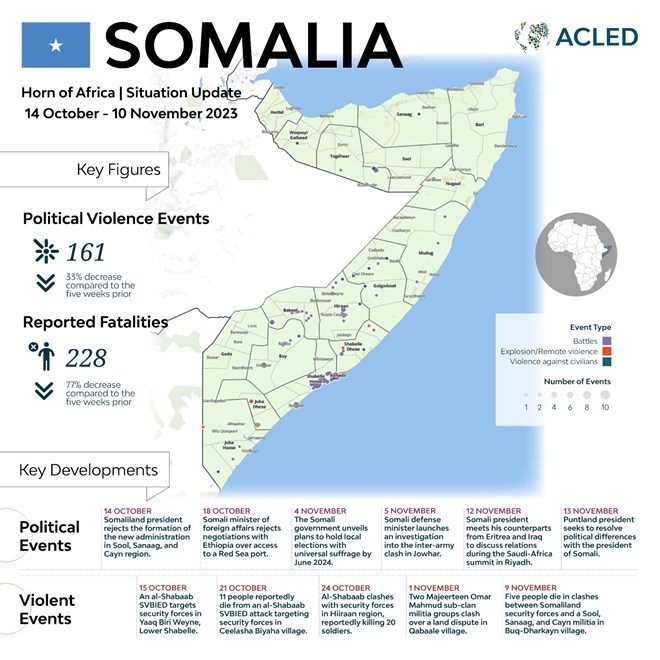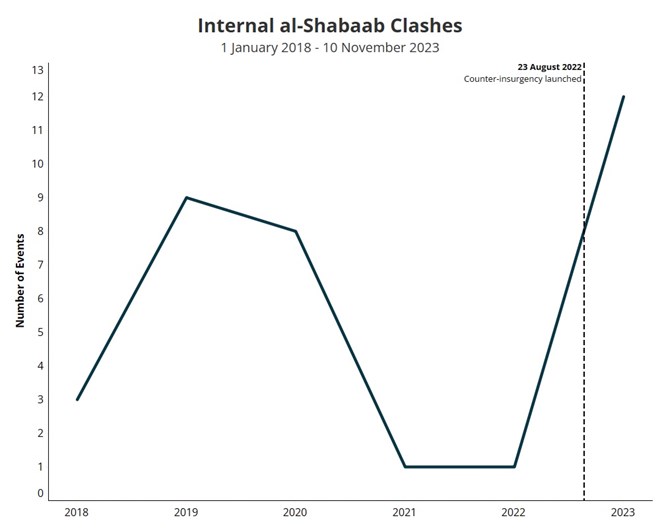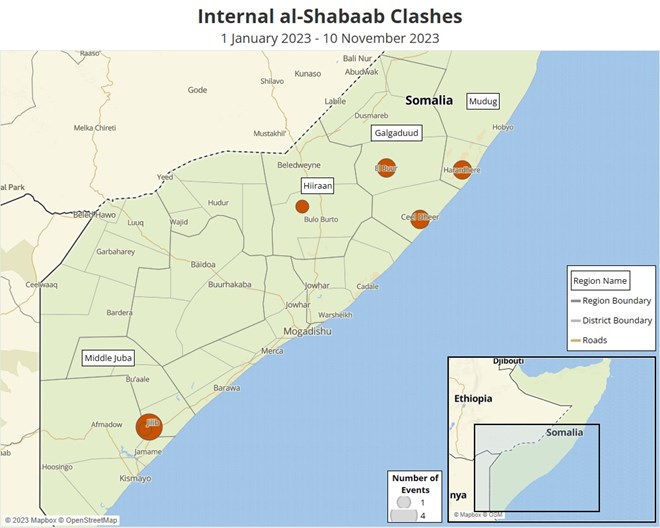
Saturday December 9, 2023

Click to enlarge
Al-Shabaab Infighting: Threat or Opportunity for the Counter-insurgency Effort?
Al-Shabaab has maintained stable leadership under Ahmed Diriye for about nine years.1 During this period, the group made advancements in areas under its control, collected taxes, and coordinated between the regions and the command center in Jilib.2 The al-Shabaab executive council has provided general operational strategies, including overseeing shifting tactics, and has been involved in the planning of high-profile attacks, with regional representatives, or shadow governors, implementing the strategies with their on field fighters. This strong connection between the leadership in the headquarters and leaders on the ground allowed coordinated attacks against security forces and civilians across different regions in Somalia.
However, a leadership crisis has recently emerged within al-Shabaab. The counter-insurgency, launched by President Hassan Sheikh Mohamud when he took power in 15 May 2022,3 mobilized security forces against al-Shabaab. As this operation began, a dispute within al-Shabaab surfaced in the group’s areas of control and strongholds in Galgaduud, Middle Juba, and Mudug regions. Disputes over leadership succession and operational strategies against government operations have led to internal conflict and, in some cases, violent clashes among al-Shabaab militants. This report outlines the reasons behind al-Shabaab’s infighting and its impact on the group’s activity in Somalia.
Mapping al-Shabaab’s Internal Conflict: Galgaduud, Middle Juba, and Mudug Regions
The instability at al-Shabaab’s Jilib command center in Middle Juba region began shortly after the government launched its counter-insurgency operation in late August 2022. From late December 2022, ACLED records 13 armed clashes among members of al-Shabaab, resulting in at least 80 fatalities as of 10 November 2023. These clashes have concentrated in Ceel Dheer and Ceel Buur towns in Galgaduud region, Jilib town in Middle Juba region, and Xarardheere village in Mudug region — all traditional al-Shabaab strongholds. Clashes in Galgaduud and Mudug regions were related to defections and surrenders to the security forces. Most of these clashes occurred from the end of December 2022 to February 2023, at the peak of the government counter-insurgency operation in these two regions. Meanwhile, clashes in Jilib began in April 2023 and were linked to disagreements within the executive on strategies for responding to the government’s counter-insurgency operation. More recently, there was a spike in clashes in October 2023, during which ACLED records four armed clashes among members of al-Shabaab, with the majority — three out of four clashes — occurring in Jilib in Middle Juba.
Before the counter-insurgency operation began, only one armed clash among members of al-Shabaab had been reported in February 2021, after Diriye took over the leadership. Before Diriye was appointed as a leader, al-Shabaab experienced a similar leadership crisis. Between 2010 and 2014, Sheikh Mukhtar Robow, also known as Abu Mansur — al-Shabaab’s then-deputy leader and spokesman — and Ahmed Abdi Godane, the then-leader, were in disagreement over management and operational strategies.4 This disagreement led to clashes between fighters loyal to the two leaders. Due to the dispute, Robow withdrew his troops from Mogadishu and, in 2013, left al-Shabaab with some loyal fighters based in Hudur, Bakool region. In August 2017, Robow surrendered to Somali authorities with his fighters.5 The leadership question currently facing al-Shabaab thus far seems to mirror this previous dispute.

Internal Leadership Feuds
Diriye, also known as Ahmed Umar Abu Ubaidah, assumed leadership of the militant group in 2014 after his predecessor, Godane, was killed in a United States airstrike in Lower Shabelle.6 It was initially expected that Mahad Warsame (also known as Mahad Karate) would lead the group after Godane’s death. However, the executive council elected Diriye as leader to facilitate the transfer of power, as he hailed from the same conservative wing as Godane.7 Karate was appointed as deputy. Following years of relative stability, a contest for succession between al-Shabaab’s top leaders began after Diriye’s health deteriorated in 2022,8 escalating into violence during the government’s counter-insurgency operation.
Karate has been at odds with Diriye over al-Shabaab’s strategies and direction since August 2022.9 This disagreement emerged after the government intensified its counter-insurgency operations and crackdown on al-Shabaab’s financial networks, including blocking more than 250 bank accounts and shutting down internet services and about 70 mobile phones belonging to the group.10 Due to this pressure from the government, al-Shabaab leaders disagree on the response strategy to the government’s military and non-military operations.
Karate has been working to undermine Diriye’s support within the al-Shabaab executive council and the group’s foreign fighters wing – the Muhajirin – by attacking members loyal to Diriye. In April 2023, fighters loyal to Karate clashed with a group of foreign fighters from Kenya called Jaabir, who are loyal to Diriye. The clash killed five people, and fighters loyal to Karate detained several foreign fighters in Jilib. The former leader of the foreign fighters, Salmaan Muhaajir, who is from Kenya, was appointed by Diriye. However, Karate appointed another fighter from Sudan to lead the foreign fighters wing and diminish the powers of Kenyan fighters loyal to Diriye.11
The conflict escalated on 3 April 2023 after Muhaajir called all foreign fighters to regroup and launch a retaliation attack at the Jilib detention center to free their members. Mohamed Amin – an al-Shabaab senior intelligence officer and a close ally of Karate – anticipated a convoy of several foreign fighters moving from Kabsuuma heading to Jilib and arrested them at Kabsuuma bridge, Lower Juba.12 Foreign fighters constitute special wings for al-Shabaab, with members mainly from neighboring countries like Ethiopia, Kenya, and Tanzania, and some from Western countries. These foreign fighters provide a wide range of services to al-Shabaab, including training and medical services.
The dispute between Diriye and Karate is still active. Currently, it appears that Karate has more supporters within al-Shabaab than Diriye, primarily due to clan affiliations.13 Karate is from the Habar Gedir sub-clan of Hawiye clan, while Diriye is from Dir clan. The Dir clan does not have a stronghold in the al-Shabaab executive council and is considered an ‘outside clan.’14 Some key members of the group aim to end the Dir clan leadership within al-Shabaab through Diriye’s removal.”15
Diriye has signaled his intention to hand over control to Sheikh Adan Abdirahman Warsame,16 also known as Adan Sunne, from Isaaq clan.17 Diriye introduced Sunne to the al-Shabaab executive council in April 2022, a move perceived as undermining prominent al-Shabaab leaders like Karate. Nevertheless, Karate seems prepared to take over the helm of al-Shabaab. On 15 September 2023, he appeared at an al-Shabaab meeting in Middle Juba region, issuing threats to the Somali government, United States forces, and others involved in ongoing counter-insurgency operations in Hirshabelle and Galmudug states.18 As this dispute deepens, it will likely result in a mix of power struggles, ideological/tactical differences, clan divisions, resource competition, and external pressures.

OUTCOME AND PROSPECT OF AL-SHABAAB’S LEADERSHIP FEUD
The leadership dispute and recent infighting within al-Shabaab have affected the cohesiveness of the group’s strategy amid active conflicts with security forces. The leadership feud has led to disagreements among al-Shabaab members, particularly regarding decisions to surrender when militants lost control of several strongholds and strategic towns in Hirshabelle and Galgaduud regions. On 31 December 2022 and 1 January 2023, two groups of al-Shabaab militants clashed in Xarardheere in Mudug region after one group of militants attempted to defect and surrender to security forces. The clashes reportedly resulted in at least 17 militants killed and several others injured. A similar clash was also reported on 20 February 2023 at the same location, resulting in at least 14 militant fatalities. These disagreements between militants occurred amid intensified operations in the region. Despite al-Shabaab leaders’ attempt to stop defections, two high-ranking leaders – Abdi Abdullahi and Nur Abdullahi Maalingur, also known as Nur Deeq – surrendered to the government in August 2023 in Bahdo and Wisil town.19
The ongoing dispute among top leaders and the defection of some district-level leaders and fighters have slightly affected al-Shabaab’s engagements with security forces. Violence involving al-Shabaab decreased from February to June 2023 and in October compared to the previous monthly average of events since August 2022 when the counter-insurgency began. The infighting has exposed the vulnerabilities of al-Shabaab and created multiple opportunities for the government. There is the possibility that these dissenting voices may lead to the formation of splinter groups or that dissenting leaders with loyal backing may defect to the government side — similar to Robow’s surrender following the 2010 to 2014 internal dispute. Moreover, as the disagreements deepen, al-Shabaab executive members may fail to provide strategies to overcome the government offensive and come up with operational tactics for the continuity of general al-Shabaab activities.